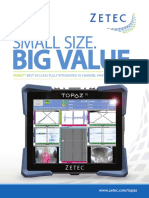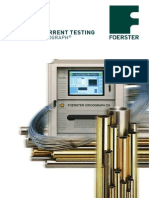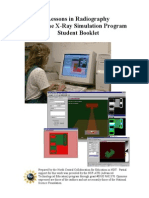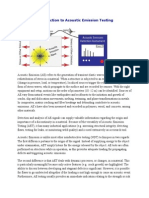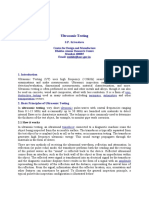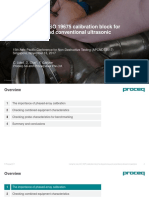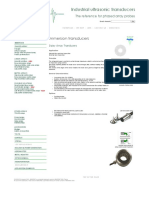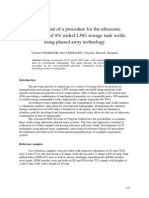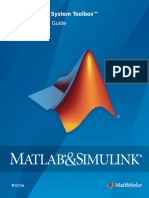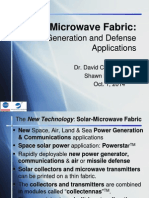NDT Ultrasonic Testing
NDT Ultrasonic Testing
Uploaded by
Space UnionCopyright:
Available Formats
NDT Ultrasonic Testing
NDT Ultrasonic Testing
Uploaded by
Space UnionOriginal Description:
Copyright
Available Formats
Share this document
Did you find this document useful?
Is this content inappropriate?
Copyright:
Available Formats
NDT Ultrasonic Testing
NDT Ultrasonic Testing
Uploaded by
Space UnionCopyright:
Available Formats
Special Report
Ultrasonic testing for detecting corrosion
Technical advances in ultrasonic test methods open up new
perspectives for damage analysis
T
he increasing use of 3D and digi- mospheres challenge the resistance to
tal non-destructive test methods chemicals of piping, tanks and valves. Dipl.-Ing. Jens Keil
supplies increasingly precise Subsequent changes of operating Head of Materials Technology
Email: jens.keil@tuev-sued.de
information on flaws and defects. Us- conditions to improve production ef-
ing a stirred tank reactor (STR) as a ficiency are a further factor promot-
Dr.-Ing. Manuel Scholz
case study, TV SD Chemie Service ing corrosion. To this end, owners/
Test Engineer Materials & Testing
presents aspects that must be taken operators often increase operating para- Email: manuel.scholz@tuev-sued.de
into consideration. In the case at hand, meters such as pressure and tempera- TV SD Chemie Service GmbH
leakage caused by corrosion occurred ture. However, a 10C increase in tem- www.tuev-sued.de/chemieservice
at a junction sheet welded onto the perature will double the rate of a chemi-
outer jacket. cal reaction and thus also accelerate the
corrosion processes. Unfortunately, array technique is a state-of-the-art
Plant operation can give rise to stakeholders do not always give suffi- pulse-echo method, which uses ultra-
conditions that were not considered in cient consideration to all these facts. sound probes made up of a number of
the design phase and in material selec- individual elements that can function
tion. Given this, in spite of a high level The phased-array ultrasonic test separately as transmitter or receiver. By
of thoroughness, corrosion is repea- method offers one possibility of iden- introducing a time delay in the excita-
tedly encountered in practice even tifying and analysing flaws such as tion of the elements, test experts can
in stainless steel and enamel-coated corrosion in solid components. This steer and focus the ultrasound beam.
components. The chemical industry is method provides reproducible results
particularly vulnerable to corrosion, for detailed analysis of the material The test data can be displayed as
as aggressive operating fluids and at- structure or welding joints. The phased- A-scans, B-scans and C-scans (see
Figures 2 and 3), i.e. in horizontal,
vertical and top view, enabling the
results to be displayed in 2D and 3D.
The phased-array technology offers
better reproducibility of results than
manual pulse-echo techniques. Com-
pared to other non-destructive test
methods such as digital radiography,
it also does not involve any radia-
tion protection measures, which often
prove cost-intensive.
Case study: stirred tank reactor
(STR)
The experts at TV SD Chemie
Service have successfully applied
the phased-array method in areas
such as damage analysis at a manu-
facturer of speciality chemicals. At
this manufacturer, leaks had occurred
in the outer jacket of a steam-heated
Fig.1: The phased-array procedure can be used to detect and assess flaws such as corrosion enamel-coated STR. The tank, built in
in solid components 1971, is equipped with an agitator and
Chemical Weekly July 9, 2013 203
Special Report
Fig. 2: The test data displayed as C-scan
processes the raw materials used for thus has the advantage of not requiring ingly use 3D and digital methods that
plastics manufacturing. It is made of removal of any coatings. deliver highly accurate results even at
high-temperature pressure-vessel steel high test speeds. However, these state-
P265 GH. This material is suitable for Technical advancement has opened of-the-art technologies also make high
the design load in this case, tem- up new perspectives for imaging, and demands on the expertise of test ex-
peratures of between 155 and 170C thus also for finding tailored solutions perts, who require extensive knowhow
at a steam pressure of 4.5 to 5 bar (450 to and actions that offer safety and relia- in handling test equipment on the one
500 kPa) and service water for cooling. bility while ensuring a high degree of hand and in interpreting the displayed
This type of steel generally offers good availability. Todays experts increas- results on the other. After all, as pre-
cold and hot forming properties and suit-
able minimum yield strength for STR
used in this segment of industry. A comparison of NDT methods
The leaks in the tank reactor oc- TOFD technique (Time of Flight Diffraction)
curred in the upper part of a junction This ultrasonic test method is particularly suitable for recognising volumi-
sheet welded to the tanks outer jacket. nous defects. The technique analyses diffracted signals rather than reflected
The junction sheet forms part of the signals and is thus highly suitable for determining the size of inhomogeneities
support ring. Reliable root-cause analy- in the material.
sis was particularly important given
that the manufacturer operated further Digital radiography
STRs of the same type under similar This radiation technique permits testing of components with coatings,
conditions at various locations. TV enamelled parts and systems that cannot be accessed from the outside. Special
SDs experts first developed a stra- evaluation systems provide immediate results, making time-intensive develop-
tegy that promised successful non-de- ment of X-ray films a thing of the past.
structive testing for investigating pos-
sible corrosion damage with the help of Phased array
the phased-array method. One option Ultrasonic testing of welds increasingly relies on the phased-array method.
was the immersion phased-array tech- The key advantage of the method is the 2D and 3D display of faults in real time
nique (based on HydroFORM). Water also in high-speed testing. Use of the test method requires expert and qualified
coupling offers optimised coupling assessment of a broad array of information.
conditions even on rough surfaces, and
204 Chemical Weekly July 9, 2013
Special Report
Fig. 3: The test data image enabling the results to be displayed in 2D and 3D
cision and resolution improve, the revealed that the defect was caused that improvements should be made
number of alleged flaws displayed in- by strain-induced corrosion cracking. to the design of the support device.
creases. Experts must therefore be able But what exactly does this mean? At A change in junction-sheet design
to differentiate between critical results higher temperatures, a magnetite layer helps to avoid load peaks, and thus
and results that pose no risk for compo- may form when water and water strain. On the other hand, the mode
nent integrity. steam in particular attacks the iron of operation of the STR should be
in the steel. The magnetite layer acts changed to ensure smaller tempera-
Interaction between people and as a protective coating, shielding the ture gradients and thus reduce ther-
technology underlying material against further mal loads (and consequently strain).
Incorrect interpretation of results corrosion. The detected flaws were lo- Based on these findings, the manu-
may lead to defects being overlooked cated in the areas exposed to the high- facturer took action, replaced the
or excessive refurbishment being un- est mechanical and thermal loads and junction sheets on a further six STRs
dertaken. This equally applies to com- the strain induced thereby. There, the and changed the service parameters
ponents that are vulnerable to corro- magnetite layer had been damaged to of the tanks. These measures have
sion, structural components and parts some extent, leaving these points vul- now significantly reduced the prob-
exposed to dynamic loads. Imperfect nerable to corrosive attacks caused by ability of corrosion and have proved
interaction between the new techno- the cooling or service water. In the that early involvement of a third-par-
logy and the qualification of the ex- case at hand, the damaged areas re- ty service provider saves costs and
perts may cause considerable follow-up peatedly recovered under service con- improves plant availability. How-
costs. Matters are further complicated ditions. The micrographs showed that ever, to reap these benefits, experts
by loss of testing know-how and test- the sides of the crack were covered by with long-standing experience must
ing experience at the manufacturers a layer of magnetite. However, in the use the right test methods and inter-
company, e.g. based on spin-off of this case at hand the existing magnetite pret the results correctly.
field of activity or increasingly fast in- layer had been repeatedly damaged
novation cycles in the research of NDT to some extent, so that corrosion pro- The testing laboratory of TV SD
applications. gressed until leakage occurred. Chemie Service offers flexible ac-
creditation, enabling the laboratory to
To return to our STR case study, An appropriate solution must validate innovative test methods itself
phased-array examination provided a take a multi-faceted approach. TV and provide for their fast application in
clear result. Further material testing SDs experts firstly recommended practice.
Chemical Weekly July 9, 2013 205
You might also like
- Detection of Natural Gas Pipeline Defects Using Magnetic Flux Leakage MeasurementsNo ratings yetDetection of Natural Gas Pipeline Defects Using Magnetic Flux Leakage Measurements6 pages
- Thermal Analysis With FLIR Cameras and MATLABNo ratings yetThermal Analysis With FLIR Cameras and MATLAB24 pages
- Ultrasonic Methods of Non-Destructive Testing: Printed Book0% (1)Ultrasonic Methods of Non-Destructive Testing: Printed Book1 page
- Interferometry: Interferometry Refers To A Family of Techniques in WhichNo ratings yetInterferometry: Interferometry Refers To A Family of Techniques in Which9 pages
- Microwave Scanning Technology For Mate-Rial Testing: ECNDT 2006 - Th.4.2.2No ratings yetMicrowave Scanning Technology For Mate-Rial Testing: ECNDT 2006 - Th.4.2.28 pages
- System Model H (T) Inlet E (T) Outlet E H (T) System Model H (T) Inlet E (T) Outlet E H (T)No ratings yetSystem Model H (T) Inlet E (T) Outlet E H (T) System Model H (T) Inlet E (T) Outlet E H (T)19 pages
- Re: RT Sensitivity Calculation: Use of Multi FilmNo ratings yetRe: RT Sensitivity Calculation: Use of Multi Film2 pages
- E1311-99 Thermal Imaging Minimum Temp DiffNo ratings yetE1311-99 Thermal Imaging Minimum Temp Diff3 pages
- 2017 Leak Detection of Water Distribution Pipeline Subject To Failure of Socket Joint Based On Acoustic Emission and Pattern RecognitionNo ratings yet2017 Leak Detection of Water Distribution Pipeline Subject To Failure of Socket Joint Based On Acoustic Emission and Pattern Recognition12 pages
- Kodak Min-R Mammography Processor: Site Specifications For The Service Code: 3752No ratings yetKodak Min-R Mammography Processor: Site Specifications For The Service Code: 375220 pages
- Doc. Eddy Current Testing Basic PrincipleNo ratings yetDoc. Eddy Current Testing Basic Principle43 pages
- Acoustic Emission Test System: SpecificationNo ratings yetAcoustic Emission Test System: Specification1 page
- EVOLUTION OF PIEZOELECTRIC TRANSDUCERS TO FULL SCALE NON-CONTACT Ultrasonic Analysis ModeNo ratings yetEVOLUTION OF PIEZOELECTRIC TRANSDUCERS TO FULL SCALE NON-CONTACT Ultrasonic Analysis Mode9 pages
- Thermography: Under The Guidance of Submitted byNo ratings yetThermography: Under The Guidance of Submitted by32 pages
- 8504 Electric Transformers, Static Converters & InductorsNo ratings yet8504 Electric Transformers, Static Converters & Inductors50 pages
- Using The New ISO 19675 Calibration Block For Phased-Array and Conventional Ultrasonic InspectionsNo ratings yetUsing The New ISO 19675 Calibration Block For Phased-Array and Conventional Ultrasonic Inspections23 pages
- How PCS Effect On Calibrated TOFD VelocityNo ratings yetHow PCS Effect On Calibrated TOFD Velocity2 pages
- Cool Experiments on Static Electricity - Science Book of Experiments | Children's Electricity BooksFrom EverandCool Experiments on Static Electricity - Science Book of Experiments | Children's Electricity BooksNo ratings yet
- Acoustic-emission-for-in-situ-quality-monitoring-in-additive_2018_Additive-MNo ratings yetAcoustic-emission-for-in-situ-quality-monitoring-in-additive_2018_Additive-M7 pages
- 2012 High Speed CT in Pressure Die Casting - CPT - 03-2012 - S42-51No ratings yet2012 High Speed CT in Pressure Die Casting - CPT - 03-2012 - S42-519 pages
- BEM Registration Invitation Letter Forms 2018 PDFNo ratings yetBEM Registration Invitation Letter Forms 2018 PDF6 pages
- BEM Registration Invitation Letter Forms 2018 PDFNo ratings yetBEM Registration Invitation Letter Forms 2018 PDF6 pages
- Reverberation Time Investigation On Automotive in Car CabinNo ratings yetReverberation Time Investigation On Automotive in Car Cabin2 pages
- Download (Ebook) Ultrasound (Second Edition) by William D. Middleton, Alfred B. Kurtz, Barbara S. Hertzberg ISBN 9780323017022, 0323017029, 2003065106 ebook All Chapters PDF100% (1)Download (Ebook) Ultrasound (Second Edition) by William D. Middleton, Alfred B. Kurtz, Barbara S. Hertzberg ISBN 9780323017022, 0323017029, 2003065106 ebook All Chapters PDF71 pages
- Concepts of MIMO Radar and Their Adv and Disadv Over Phased ArrayNo ratings yetConcepts of MIMO Radar and Their Adv and Disadv Over Phased Array7 pages
- Lens Antenna Subarrays in Mmwave Hybrid MIMO SystemsNo ratings yetLens Antenna Subarrays in Mmwave Hybrid MIMO Systems11 pages
- Synthesis of Cosecant Squared Pattern in Linear AnNo ratings yetSynthesis of Cosecant Squared Pattern in Linear An5 pages
- The Electronically Steered Phased FinalNo ratings yetThe Electronically Steered Phased Final26 pages
- I.seker - Calibration Methods For Phased Array RadarsNo ratings yetI.seker - Calibration Methods For Phased Array Radars16 pages
- 2008 Development of A Procedure For The Ultrasonic Examination of Nickel LNG Storage Tank Welds Using Phased Array TechnologyNo ratings yet2008 Development of A Procedure For The Ultrasonic Examination of Nickel LNG Storage Tank Welds Using Phased Array Technology5 pages
- Phased Array Radar Basics: Jeffrey Herd MIT Lincoln LaboratoryNo ratings yetPhased Array Radar Basics: Jeffrey Herd MIT Lincoln Laboratory17 pages
- Integrated Masts The Next Generation MasNo ratings yetIntegrated Masts The Next Generation Mas9 pages
- MATLAB Phased Array System Toolbox Getting Started Guide. R2020aNo ratings yetMATLAB Phased Array System Toolbox Getting Started Guide. R2020a28 pages
- Solution To Microwave Engineering Pozar Chapter 14 Exercise 5 With MATLABNo ratings yetSolution To Microwave Engineering Pozar Chapter 14 Exercise 5 With MATLAB15 pages
- Limitations of AESA's On Monopulse Beamforming 2016 IEEENo ratings yetLimitations of AESA's On Monopulse Beamforming 2016 IEEE2 pages





